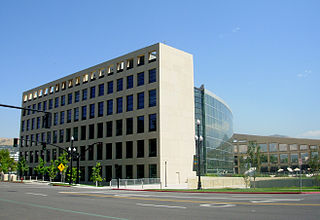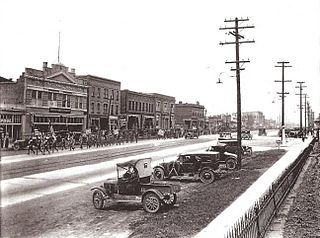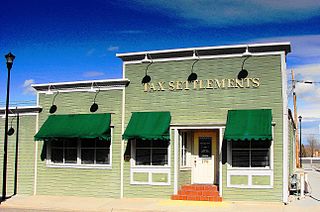
Temple Square is a 10-acre (4.0 ha) complex, owned by The Church of Jesus Christ of Latter-day Saints, in the center of Salt Lake City, Utah. The usage of the name has gradually changed to include several other church facilities that are immediately adjacent to Temple Square. Contained within Temple Square are the Salt Lake Temple, Salt Lake Tabernacle, Salt Lake Assembly Hall, the Seagull Monument, and two visitors' centers. The square was designated a National Historic Landmark District in 1964, recognizing the Mormon achievement in the settlement of Utah.
The Avenues is an affluent neighborhood in Salt Lake City, Utah. It is named after the perfectly gridlike, closely laid out roads called Avenues and Streets. First surveyed in the 1850s, the Avenues became Salt Lake City's first neighborhood. Today, the Avenues neighborhood is generally considered younger, more progressive, and somewhat "artsy" when compared to other neighborhoods. Many young professionals choose to live there due to the culture and easy commute to downtown.. It is also one of the most important strongholds of the Democratic political party in Utah.

The Salt Lake City Council Hall is currently home to offices of the Utah Office of Tourism and the Utah Film Commission and is located on Capitol Hill in Salt Lake City, Utah. Built in 1864-66, the building is historically important as the Old Salt Lake City Hall or just Old City Hall from 1866 to 1894. It was designated a National Historic Landmark in 1975, as an emblem of the conflicts between the governments of the Utah Territory and the United States in the 19th century.

Capitol Hill in Salt Lake City gets its name from the Utah State Capitol prominently overlooking downtown. In addition, Capitol Hill can be considered a neighborhood of Salt Lake City.

Salt Lake City, Utah has many historic and notable sites within its immediate borders. Although the entire Salt Lake City metropolitan area is often referred to as "Salt Lake City", this article is concerned only with the buildings and sites within the official city limits of Salt Lake City.

The Utah Territorial Statehouse, officially Territorial Statehouse State Park Museum, is a state park in Fillmore, Utah, preserving the original seat of government for the Utah Territory. Built from 1852 to 1855, the statehouse was initially intended as a larger structure, but only the south wing was completed before the project was abandoned due to lack of federal funding, and the Utah Territorial Legislature met in the building only once before the capital was moved to Salt Lake City in 1856.

Summit Avenue is a street in St. Paul, Minnesota, United States, known for being the longest avenue of Victorian homes in the country, having a number of historic houses, churches, synagogues, and schools. The street starts just west of downtown St. Paul and continues four and a half miles west to the Mississippi River where Saint Paul meets Minneapolis. Other cities have similar streets, such as Prairie Avenue in Chicago, Euclid Avenue in Cleveland, and Fifth Avenue in New York City. Summit Avenue is notable for having preserved its historic character and mix of buildings, as compared to these other examples. Historian Ernest R. Sandeen described Summit Avenue as "the best preserved example of the Victorian monumental residential boulevard."

The Salt Lake City Public Library system is a network of public libraries funded by Salt Lake City. The Free Public Library of Salt Lake City first opened on February 14, 1898. The system is under the direction of a library board and circulates more than three million items each year.

The Henry J. Wheeler Farm is a farmstead in Murray, Utah, United States, that one of the few remaining late 19th century farmsteads in the Salt Lake Valley that have not been lost to expanding housing developments of metropolitan Salt Lake City. It was listed on the National Register of Historical Places since 1976.\

The Murray Downtown Historic District is located in the historic city center of Murray, Salt Lake County, Utah. It was listed on the National Register of Historic Places in 2006, with a boundary increase in 2020.
Ware & Treganza was a leading American architectural firm in the intermountain west during the late 19th and early 20th century. It was a partnership of Walter E. Ware and Alberto O. Treganza and operated in Salt Lake City, Utah.
Richard Karl August Kletting was an influential architect in Utah. He designed many well-known buildings, including the Utah State Capitol, the Enos Wall Mansion, the original Salt Palace, and the original Saltair Resort Pavilion. His design for the Utah State Capitol was chosen over 40 competing designs. A number of his buildings survive and are listed on the U.S. National Register of Historic Places including many in University of Utah Circle and in the Salt Lake City Warehouse District.

The Sandy Historic District is a Historic District in Sandy, Utah that covers most of the city's pre-suburbanization extent. It is essentially the area east of State Street, west of 700 East north of 9000 South, and south of Pioneer Avenue. About half of the National Register of Historic Places listings in Salt Lake County outside of Salt Lake City are in Sandy, and the large majority of those are within the Historic District.

Elias Lacy Thomas Harrison was an architect and writer in Salt Lake City, Utah, who became important in the history of Utah and the Latter Day Saint movement.

The Warehouse District of Salt Lake City, Utah, is a historic district on the city's west side. The area has been occupied by artists, and worked on by developers. A small portion of its area was added to the National Register of Historic Places in 1982, and the listing was greatly enlarged by a boundary increase in 2016.

The Winthrop Street Historic District encompasses a predominantly residential area of Augusta, Maine encapsulating about 100 years of residential home development. The area features high-quality and well-preserved examples of homes from the early 19th to early 20th centuries, as well as two churches and the Lithgow Library. The district occupies a roughly triangular area west of downtown Augusta and north of the state capitol district. It was listed on the National Register of Historic Places in 2001, and enlarged slightly in 2008.
The Boulevard Gardens Historic District is an historic district roughly bounded by Quayle Avenue, Main and West Temple Streets, in Salt Lake City, Utah. The district was listed on the National Register of Historic Places on December 31, 2018.

The Willard Historic District, is a historic district in Willard, Utah, United States, that is listed on the National Register of Historic Places (NRHP).

The University Neighborhood Historic District is a 180 acres (73 ha) historic district near the University of Utah campus in northeastern Salt Lake City, Utah, United States, that was listed on the National Register of Historic Places in 1995.



















